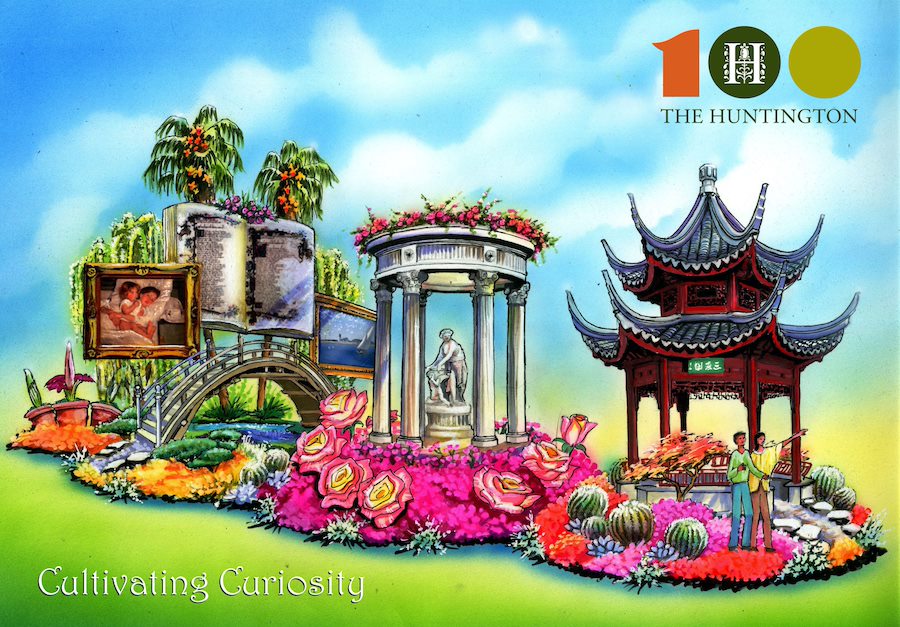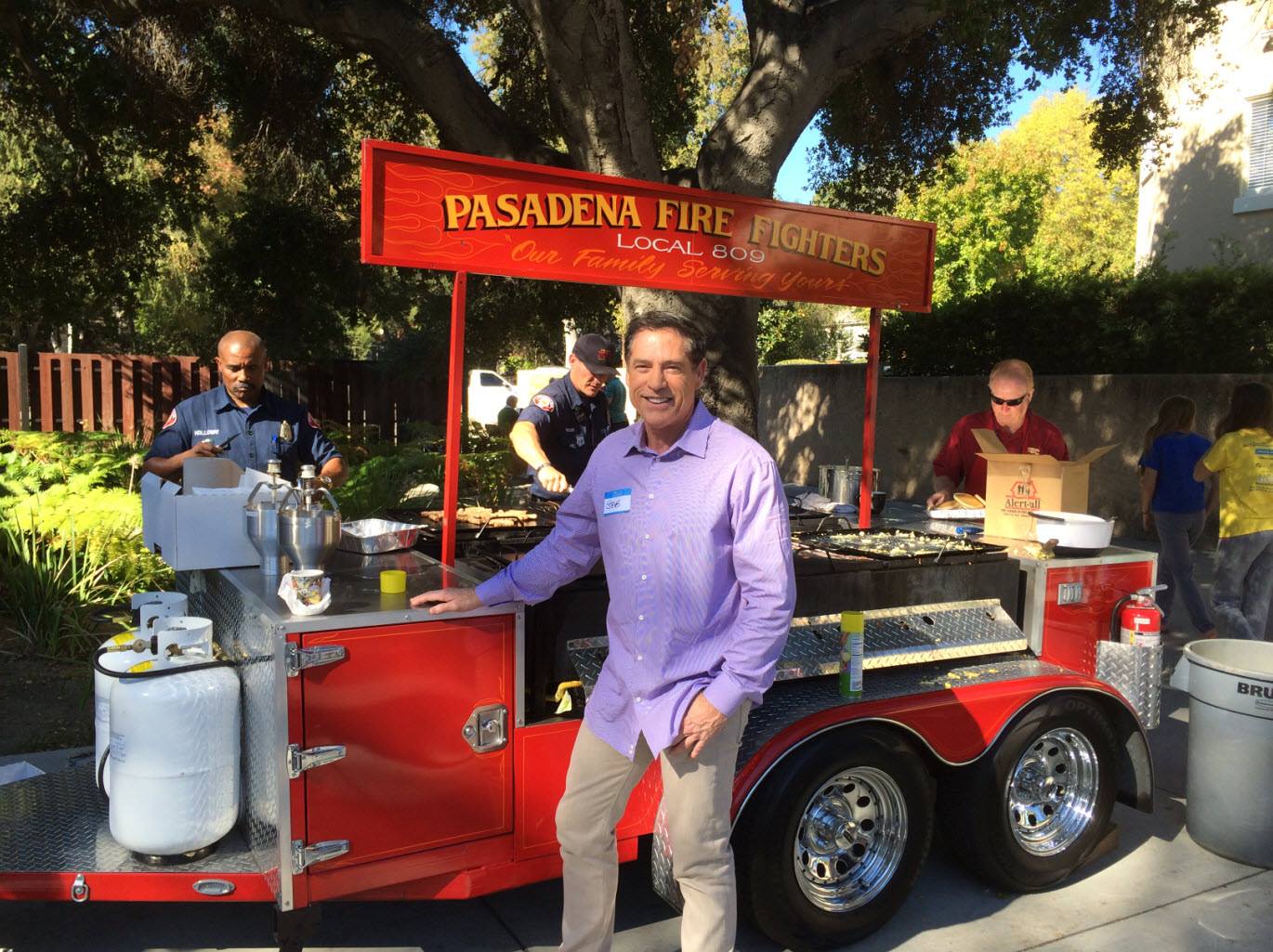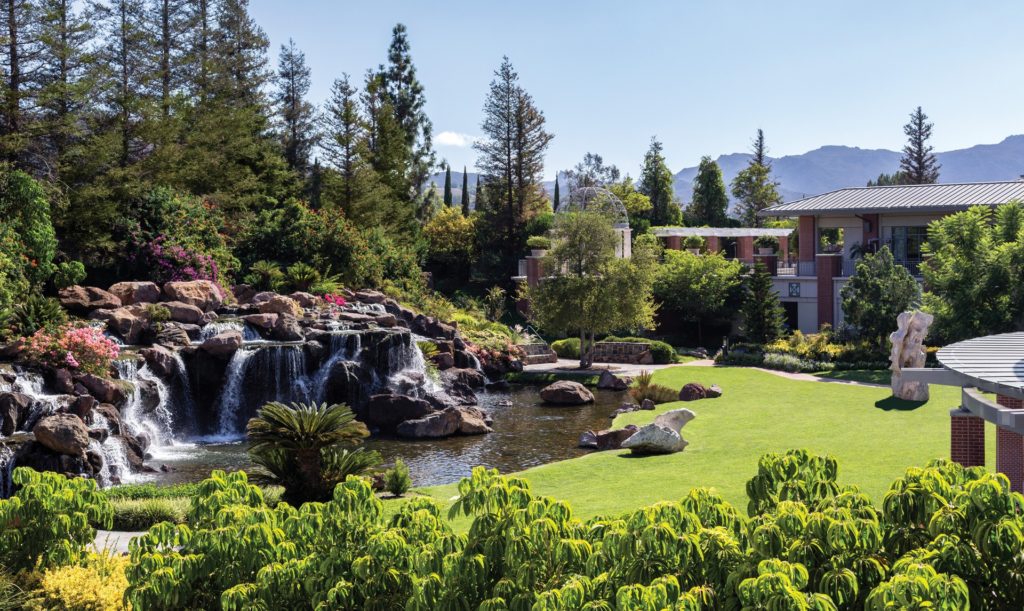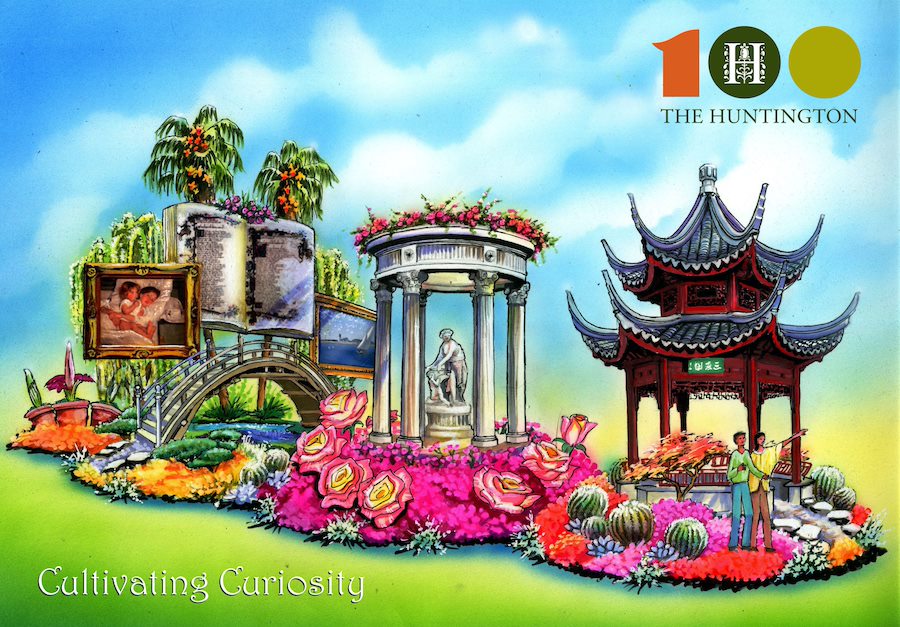
By May S. Ruiz
The Huntington Library, Art Museum, and Botanical Gardens will mark another historic event as its own float travels down Colorado Blvd. for the Rose Parade, 50 years since it last made an appearance at Pasadena’s famous New Year’s Day floral, equestrian, and marching band pageant.
Themed ‘Cultivating Curiosity,’ the 55-foot long float captures the spirit of The Huntington’s Centennial Celebration and highlights its rare research materials, inspiring art collections, and unparalleled botanical gardens which have made it a beloved destination that welcomes 750,000 visitors each year.
In 1969, the city of San Marino sponsored an entry that featured floral depictions of the institution’s world-renowned paintings ‘The Blue Boy’ and ‘Pinkie,’ an imposing replica of the historic Library building’s façade, and the Ellesmere manuscript of Chaucer’s ‘The Canterbury Tales.’ The float won the Grand Marshal’s Trophy. This year, The Huntington commissioned a float for the first time.

Chatting with me by phone, Randy Shulman, The Huntington’s VP for Advancement and External Relations says “The last time we were represented at the Rose Parade, it was done by the city so it’s as if we’re doing it for the first time – it’s all Huntington content and people. It’s our centennial and it’s an opportunity to help celebrate and raise awareness of The Huntington and its centennial year.”
I ask why they’d never done it before and Shulman replies, “The Huntington is a non-profit that raises its operating expenses every year. External promotion is never going to be the top priority. Always, the top priorities will be running its education programs and doing its academic mission. The thought of doing a Rose Parade float is an exceptional moment so we need an exceptional moment. That’s why we chose to do it now.
“The decision to sponsor a Rose Parade float came out of a discussion of the Board and some of the people in our board community who said ‘This is a great moment.’ Our president, Karen Lawrence, joined The Huntington a little over a year ago and she was very quickly enthusiastic about it. So, we have a new president, it’s a new time, it’s a hundred years – all the planets aligned. Additionally, we were able to find private donors who would help us make it possible. Every dollar of the cost of the float is through donations, not through our operating budget.
“We had just told our entire donor community that we’re doing this float and if they wanted to volunteer we had 1,000 spots for people to volunteer and if they wanted to help by making a donation, that would be welcomed. And some people have done that. We posted the volunteer sign-up to help decorate our float on our website and spots were filled rapidly.”
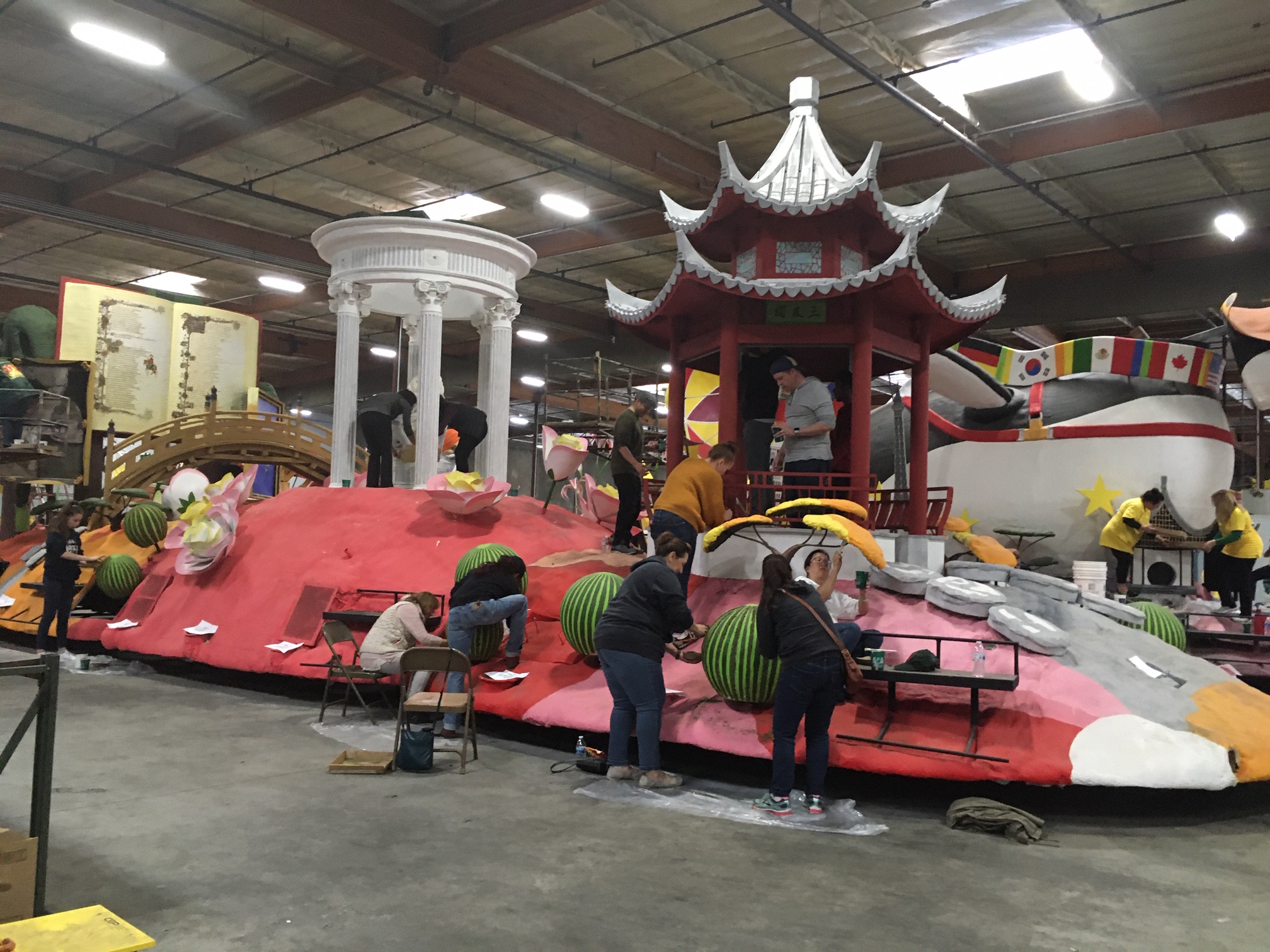
Choosing the float builder was a competitive process. Shulman discloses, “We had the major builders provide proposals and we evaluated based on the design and the background of the float builder. The design of the float itself came out of a desire to represent not just the Huntington that people are familiar with, but one that integrates discovery and curiosity. We wanted to have some familiar things that people recognize as well as other things that people may not recognize. The end of the float is the ‘Stinky Flower’ which is a playful way of talking about The Huntington’s very unusual Botanical Garden collection. Some of the materials being used are grown here – seeds, pods, bark, and some leaves. And that’s really great – it talks about us and the place. It’s also fun for many people who have been here and walked the place to see the familiar sights depicted on the float.”
Given the numerous significant things at The Huntington, I inquire how difficult it was to come down to seven elements that would be represented on the float. Shulman responds, “We asked the directors of the Library, the Art Museum, and the Botanical Gardens for their thoughts. But, of course, things decided by a committee never work out because it’s hard for a lot of people to have a consensus. What we did want to do is to keep it simple, recognizable to a point, but we also wanted to have a sense of playfulness. What people won’t see on the float are some of the more recognizable items like ‘Blue Boy’ or Shakespeare’s folio. But that’s because we want the opportunity to show something very beautiful that people might not know about.
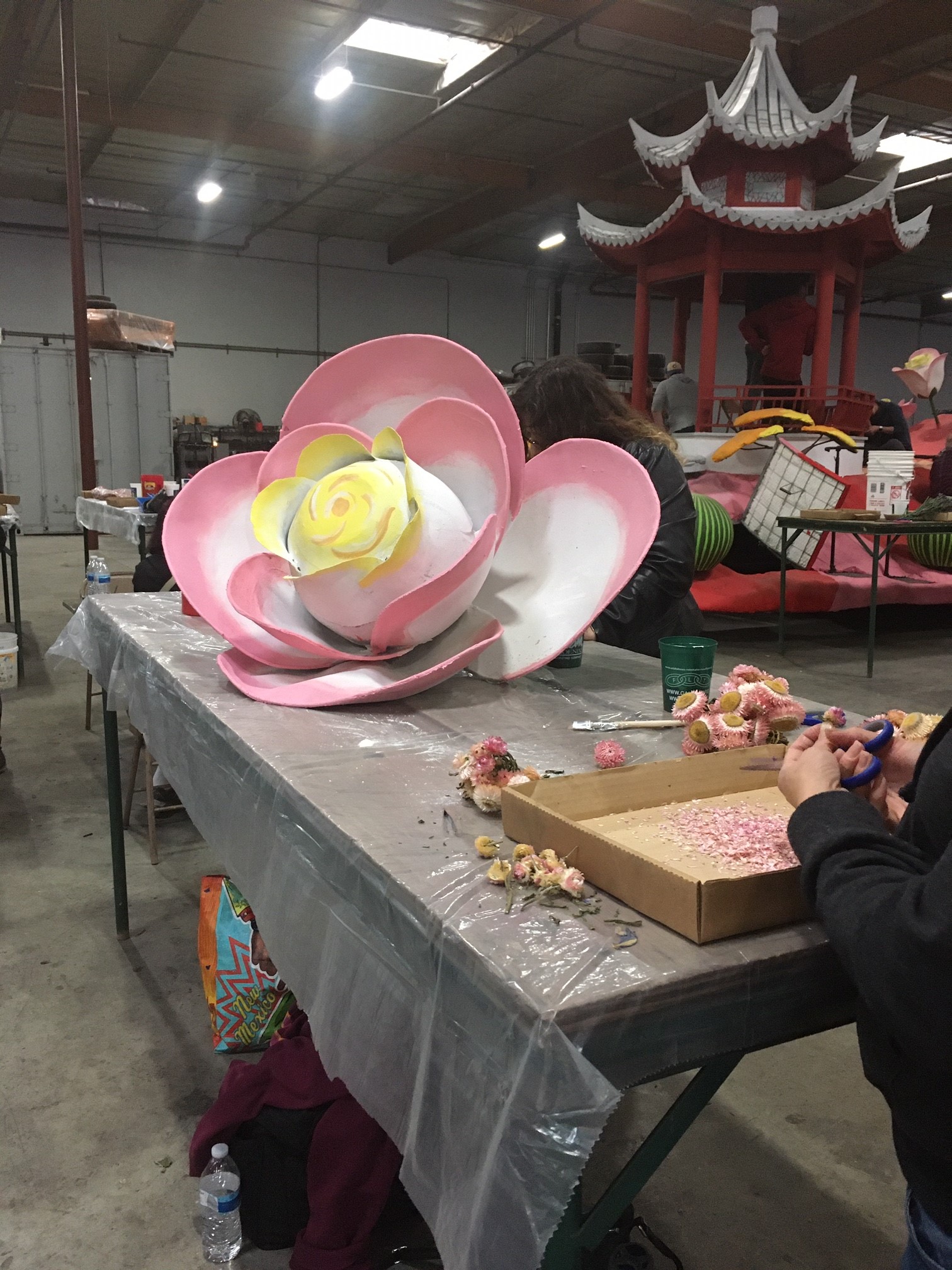
“That was one of our President’s goals. She wants to have that moment when people say ‘What is it? I have to go see.’ She wants to have people have that joy of discovering more about The Huntington. It’s a complex place. There’s so much happening here with the different collections in the gardens and there’s always something new to discover in the gallery as well. Our float is a manifestation of the joy of The Huntington’s 100 years – both getting to the hundred-year mark but also looking forward to the next centennial.”
The Huntington’s float will have eight riders and will be followed by six walkers as it makes the 5.5-mile journey down Colorado Blvd. The float riders will include four youth participants from The Huntington’s community partner programs with the Heart of Los Angeles (HOLA) and the Pablove Foundation; Huntington President Karen R. Lawrence; two lucky staff members who won a staff-wide raffle; and leadership donor and member of The Huntington’s Board of Governors Mei-Lee Ney. The walkers following the float will include five of The Huntington’s teen volunteers and one adult supervisor.

It was the design submitted by prominent float builder Phoenix Decorating Company (PDC) that won The Huntington’s vote. Curious to see what the float looks like, I visit their Irwindale site on the first day that volunteers arrive to help decorate. Chuck Hayes, Sponsor Relations Manager at PDC, is a gregarious man who warmly welcomes me and eagerly explains their association with the San Marino institution.
“The Huntington said they wanted a 55-foot float and detailed the elements they wanted on it. We conferred with them throughout the conceptual process – we held multiple meetings, made many visits to the facility, and took several images from which to come up with a design. Our artist worked directly with their team to arrive at something that included the components and fitted their requirements. We’re the interpreter of their concept and all the materials we’re using on the float help realize that vision. It’s what makes me proud to be a float builder – to be able to honor organizations like The Huntington. Every single float we build is a unique prototype, each is a one-off, and has never been done before. Floats are built by hand from scratch – from the design stage to getting each petal onto the float.
“The Rose Parade is a Southern California tradition and, as a float builder, we always want to give our clients the greatest thrill at that moment when they walk up to see it for the first time. We build everything to scale so people who are watching it along the parade route can really focus on the float. There’s so much for them to take in – while the float is traveling down the five-and-a-half mile-parade route at 2.5 miles per hour, there might be a marching band in front and equestrian riders behind it. We made sure that people who have never been to The Huntington would be compelled to visit it after seeing this float.”
Hayes continues, “Phoenix has been an award-winning Rose Parade float builder for 37 years. We have a team of professionals that works year-round constructing and deconstructing floats. We begin in January when the Tournament of Roses announces the theme for any given year – for 2020 it’s ‘The power of Hope.’ That becomes our emphasis and it’s how we bring everyone into the fold. The client comes into the parade excited – some have never seen a float before, some have never commissioned one so they don’t know what’s involved. We sit with them and we tell them what we do, show them pictures of floats we’ve built and decorated. Sometimes, clients hear about something we’d done through word of mouth, or have seen a project we worked on like ‘Earth, Wind, and Fire’ which the Forum commissioned to celebrate their 50th anniversary. That’s what The Huntington was looking for – something uniquely theirs.
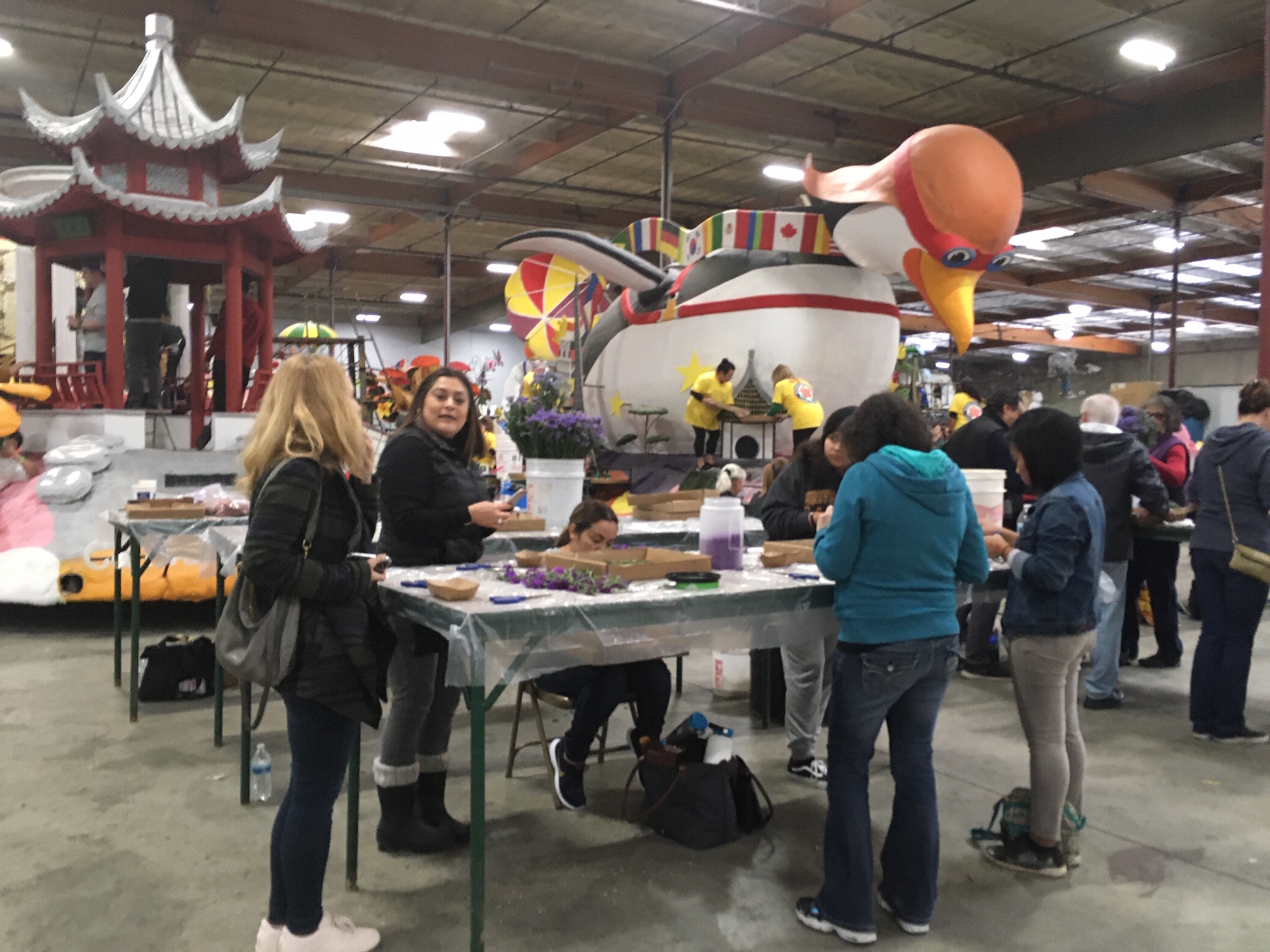
“We have anywhere from 25 to 40 people on staff – artists and construction crew – at various times. The number expands as the activity progresses and we hire crew chiefs and assistant crew chiefs who work on specific floats. The decoration can be done by the organization’s volunteers and by anyone who wants to decorate. They can sign up on our website, on the Kiwanis site, or through the ‘Petal Pushers.’ Our crew chiefs and assistant crew chiefs work with the volunteers who show them how to glue the materials onto the float. The Huntington brought so many volunteers to fill the decorating shifts. But if, for some reason, a client didn’t have people show up, their float would still be ready to go down Colorado Blvd. on New Year’s Day.”
On the day I visit Phoenix, a coordinator with Tournament of Roses (TofR) is there and Hayes introduces me to her. That also prompts him to expound, “This is the 131st year of the Rose Parade. If it wasn’t for them we wouldn’t have a parade. They give the opportunity for organizations like The Huntington to get worldwide exposure; I believe they said somewhere in the world, the parade is shown every day of the year – because of tape delays in other countries. There are over 700,000 on the parade route, a regional and national TV audience, and international viewers. And with social media, people can now react and let others know what floats they like in real time. Awareness about the parade just keeps expanding.”
People watching the Rose Parade on Colorado Blvd. and television viewers everywhere will have the delightful experience of seeing a Huntington float that depicts the following iconic elements in The Huntington’s collections:

Pavilion of the Three Friends
Located in Liu Fang Yuan, the Chinese Garden at The Huntington, the Pavilion of the Three Friends is named for the ‘three friends of winter’: bamboo, pine, and plum. They are symbols of fortitude, integrity, and resilience. Carvings of these signature plants adorn the ceiling of the pavilion and also grow nearby.
The pavilion’s roof will be covered with eucalyptus leaves of green/grey. Painted tiles are made of light grey and dark grey lettuce seed. The main body is covered in red fine cut strawflower, white fine ground rice and light grey, light lettuce seed. Window insets are covered in light blue fine cut statice, green fine ground split pea, and shiny grey silverleaf.
The pathway of light is made of grey light lettuce seed; rocks of light grey, light lettuce seed and white fine ground rice; accents of green mood moss.
Maple trees have tops of orange and yellow dendrobs with underneath areas of green ground parsley flakes and branches of dark brown coffee.
Sculpted barrel cacti are covered in ground parsley flakes and light green carnation calyx. Flowers on top are bright yellow whole strawflowers. Juvenile golden barrel cacti are provided by Huntington Gardens. The area around small cacti is grey Spanish moss.

Rose Garden Tempietto
The centerpiece of The Huntington’s historic Rose Garden, the 18th-century French stone tempietto houses a sculpture – Love, the Captive of Youth – which depicts Cupid and his captor, a fair maiden. Appropriately, the tempietto is encircled by a bed of ‘Passionate Kisses’ roses. The three-acre Rose Garden contains more than 3,000 individual plants and more than 1,250 different cultivated varieties (cultivars), including Huntington’s 100th, the newly hybridized rose marking The Huntington’s Centennial.
Rose Garden Tempietto is covered in white powdered rice, light grey ground white pepper, and dark grey poppy seed. Floral on top is made of green asparagus plumose, hot pink roses, and white and light pink dendrobs. Sculpted centennial rose petals are light pink and white gladiola petals, yellow and bronze fine cut strawflower, and white powdered rice.

Japanese Moon Bridge
Completed circa 1912, the distinctive Moon Bridge is an iconic feature of The Huntington’s celebrated Japanese Garden. Commissioned by Henry Huntington himself, the Moon Bridge was built by Japanese craftsman Toichiro Kawai. The bridge’s high arch and reflection in the still pond below form a circle, reminiscent of the moon.
Japanese Moon Bridge is comprised of tan paper bark with underneath coverage of tan fine walnut and dark brown coffee; finials of black seaweed. Bonsai trees have tops of green mood moss, underneath areas of green ground parsley flakes, with branches of dark brown coffee. The pond has edges of green mood moss and water of purple, light blue, and dark blue iris.
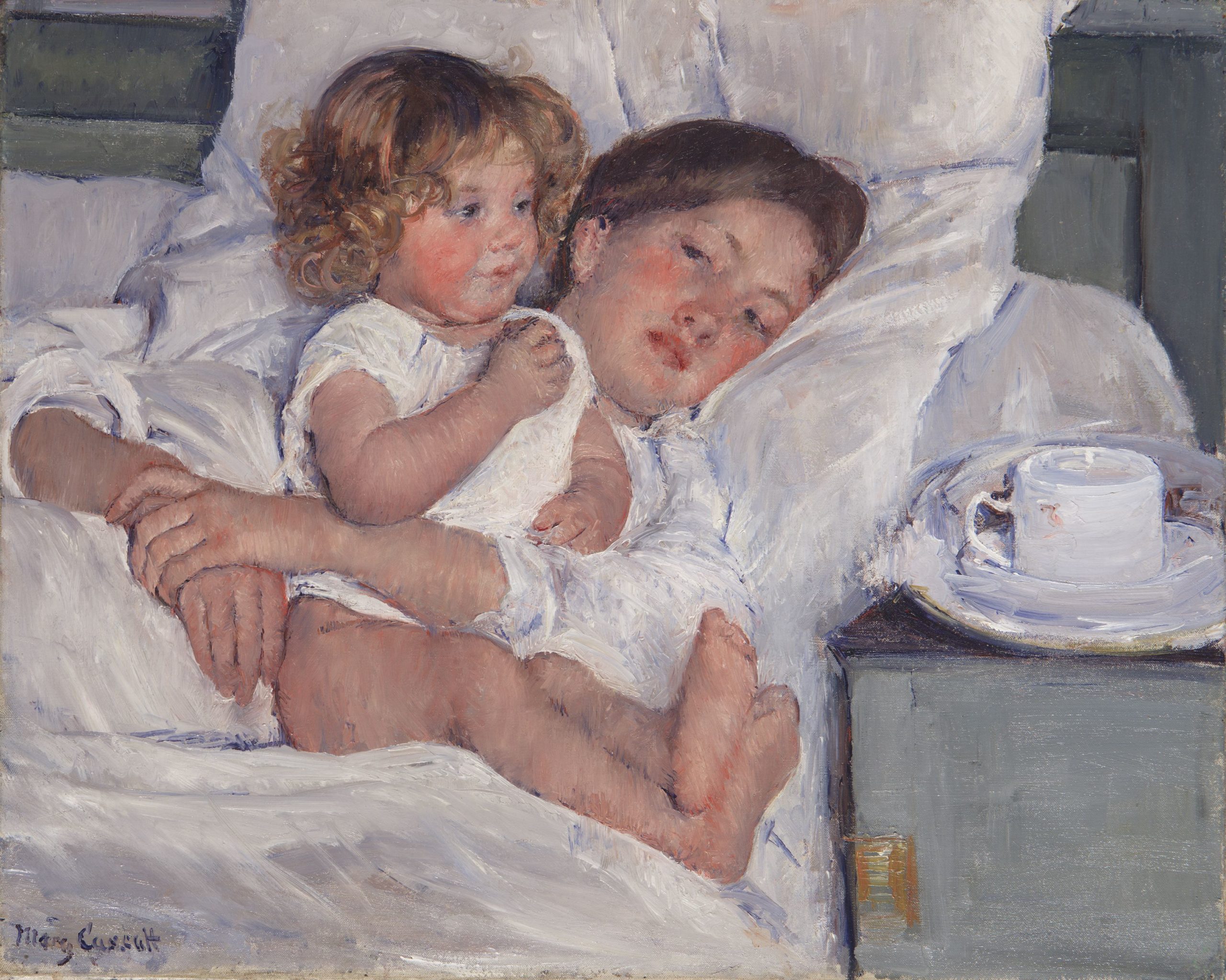
‘Breakfast in Bed’ by Mary Cassatt
Painted in 1897 by famed American Impressionist Mary Cassatt, ‘Breakfast in Bed’ is one of the most-beloved portraits in The Huntington’s collection. Cassatt’s work often depicts the social and private lives of women; she is well known for capturing the intimate bonds between mothers and children.
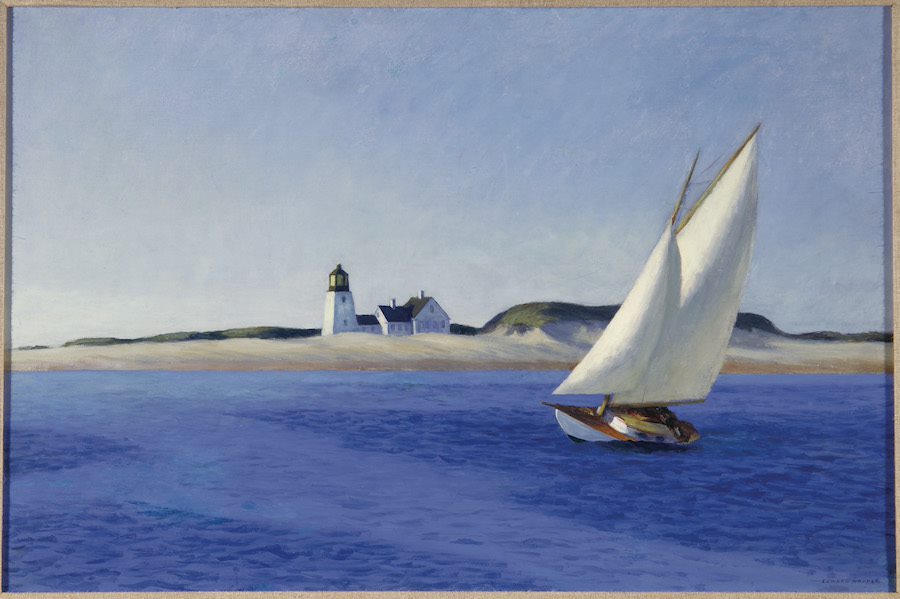
‘Long Leg’ by Edward Hopper
The ‘Long Leg’ by Edward Hopper was painted in 1935 and has been a favorite painting among Huntington visitors since its debut in 1984 as one of the artworks that established the American art collection. With a nearly all-blue composition, the painting reflects two of Hopper’s favorite themes: sailing and the sea. In 2011, as part of the U.S. Postal Service’s American Treasures series, the work was issued as a postage stamp.
‘Breakfast in Bed’ by Mary Cassatt and ‘Long Leg’ by Edward Hopper feature frames of dark brown coffee, gold clover seed and light yellow fine cut strawflower. Backs of black onion seed. Floragraphs of various spices and seeds.
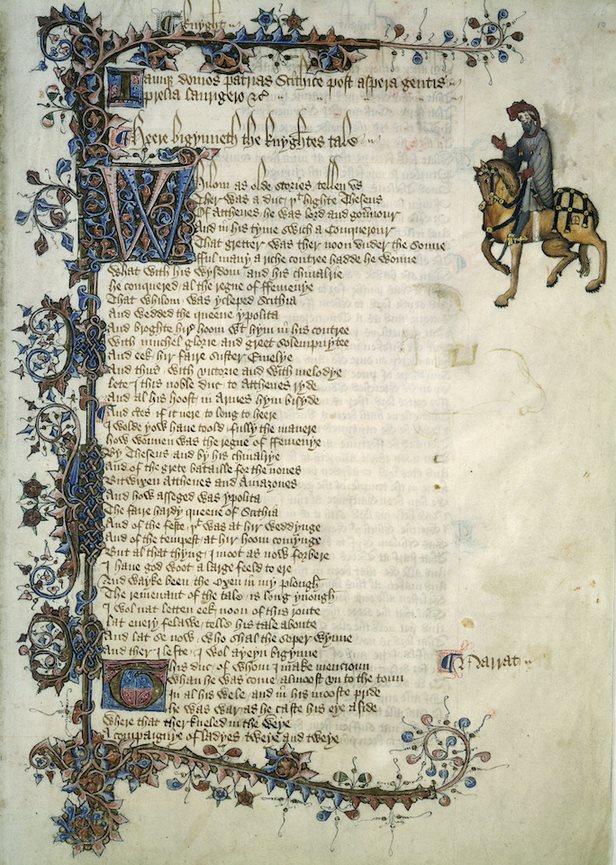
The Ellesmere Chaucer
The elaborately decorated Ellesmere manuscript of Geoffrey Chaucer’s ‘The Canterbury Tales’ was created sometime between 1400 and 1410. It contains what is believed to be a portrait of Chaucer as well as miniature paintings of 22 other fictional pilgrims who tell stories in order to enliven the journey from London to Canterbury. The medieval manuscript is on parchment.
The Ellesmere Chaucer has pages of white powdered rice, black onion powder and dark grey poppy seed. Binder is of red fine cut strawflower; floral top has green springeri, dark lavender roses, dark lavender carnations, and green leather fern.
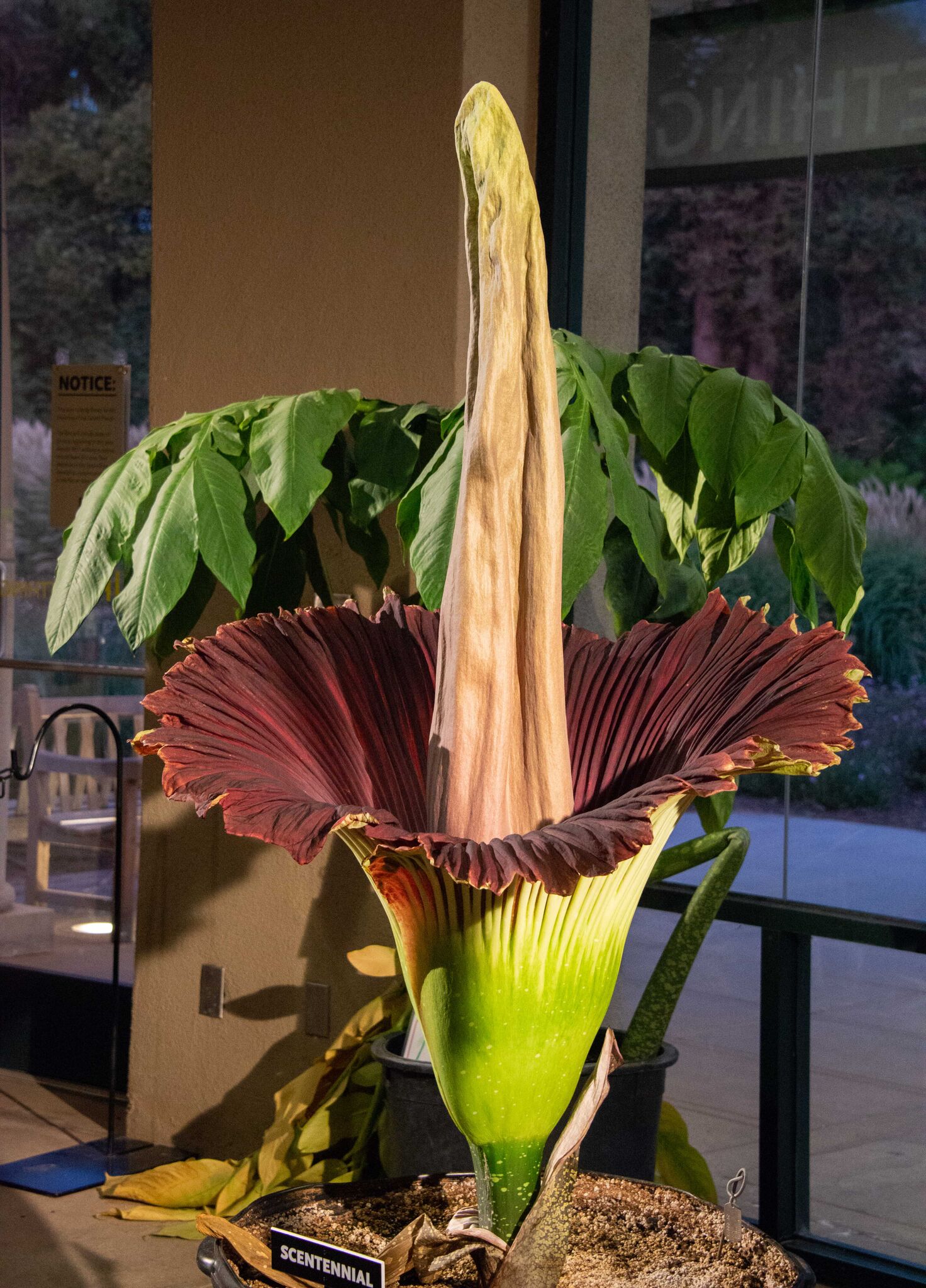
Corpse Flower
In August of 1999, a rare corpse flower bloomed at The Huntington—the first known flowering of this exotic species in the state of California. This exciting (and smelly) occurrence provided an opportunity for thousands of visitors to witness one of the wonders of the botanical world. Since that extraordinary event, The Huntington has produced nine additional blooms—most recently on July 24, 2019—and has shared seeds and pollen with botanical gardens across the country.
Palm tree fronds have tops of green komodor fern, underneath of green ground parsley flakes, floral of yellow and orange cymbidiums, and trunks of reddish/brown palm bark with fiber. The bases of palms are sago palms with green cycad leaves provided by Huntington Gardens.
Corpse flowers are crème sesame seed, green fine ground split pea, and dark purple and red fuzzy cut strawflower; pots of red fine cut strawflower.
Deck of green is made of springeri, hot pink and red roses, red anthuriums, light pink, orange and pink roses, peach anthuriums, peach roses, orange and white with green “geisha” anthuriums, green springeri, and white cattleyas. Green leather fern, white dendrobs, white tiger lilies, coco stix with powdered rice and white starburst mums.
In a news release the communications department sent out this summer, Karen Lawrence expressed the institution’s message. “The Huntington’s incomparable collections have had an extensive reach over the past century, and we expect them to continue to inspire visitors, new and old, for the next 100 years in powerful and unpredictable ways. We welcome the national and international exposure that this celebrated parade provides and look forward to this joyful moment during our Centennial as a way of sharing our treasures with audiences the world over.”

